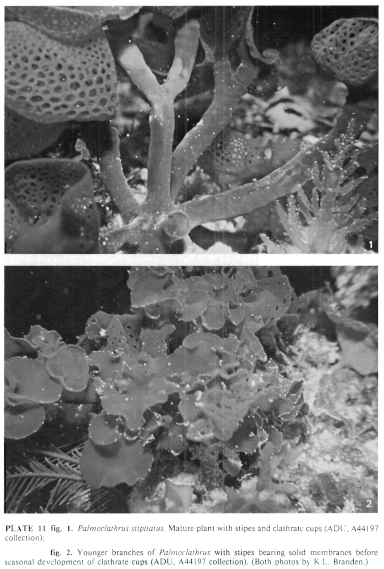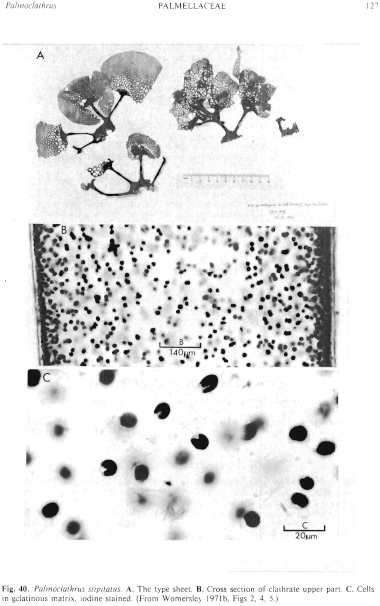|
|
|
|
|
|||||||||||
|
Electronic Flora of South Australia Species Fact Sheet
Phylum Chlorophyta – Order Tetrasporales – Family Palmellaceae
Thallus (P1. 11, Fig. 40A) medium to dark green, epilithic with a spreading discoid base 1–4 (–6)cm across and 1–8 erect stipes to 8 cm high and 5–10 mm in diameter, simple or occasionally branched and often with annular ridges at their upper end. Disc at upper end of each stalk to 2 cm across, 1–2 mm thick and solid, then continuing from its margin as a cup-shaped, perforate membrane (Fig. 40A) to 15 cm across, becoming slightly undulate and with the perforations arising marginally and reaching 5 mm in diameter away from the margin. Structure (Fig. 40B,C) of ovoid cells 8–10 µm across with a single cup-shaped chloroplast without pyrenoid or eyespot, irregularly arranged (denser near the frond surfaces) in a firm gelatinous matrix. Pigments typical of the Chlorophyta but with almost equal amounts of chlorophyll b and chlorophyll a.
Reproduction: Reproduction unknown.
Type from Waldegrave I., S. Aust., 22 m deep (Shepherd, 23.x.1970; ADU, A37363).
Distribution: Known from several collections from Waldegrave Island (e.g. Branden, 25.x.1973; ADU, A44197-"Marine Algae of southern Australia" No. 144). D'Estrees Bay, Kangaroo I., S. Aust., drift (Kraft, 17.i.1974; ADU, A44606). 9–12 km S. of Port MacDonnell, S. Aust., 45–60 m deep (R. K. Lewis, 9.ix.1975, 19.x.1975 and 27.ii.1978; ADU, A46507, A46616 and A46969 respectively). Discovery Bay, Vic., 45 m deep (Kraft, 25.i.1977; ADU, A47990).
Taxonomic notes: This remarkable alga is only known from deep water but in such localities may be common. At Waldegrave Island and off Port MacDonnell the stipes are present throughout the year but the clathrate upper parts disintegrate in winter and new ones arise in spring, becoming fully developed in summer. The stipes are thus probably perennial and their annular ridges may indicate the seasonal development of the clathrate membranes.
Palmoclathrus is provisionally placed in the Palmellaceae. It is clearly a much more highly evolved plant than other members of this group.
References:
WOMERSLEY, H.B.S. (1971b). Palmoclathrus, a new deep water genus of Chlorophyta. Phycologia 10, 229–233.
The Marine Benthic Flora of Southern Australia Part I complete list of references.
Publication:
Womersley, H.B.S. (31 May, 1984)
The Marine Benthic Flora of Southern Australia
Part I
©Board of the Botanic Gardens and State Herbarium, Government of South Australia
Illustrations in Womersley Part I, 1984: PLATE 11; FIG. 40.

Plate 11 enlarge
PLATE 11 Fig. 1. Palmoclathrus stipitatus. Mature plant with stipes and clathrate cups (ADU, A44197 collection);
Fig. 2. Younger branches of Palmoclathrus with stipes bearing solid membranes before seasonal development of clathrate cups (ADU, A44197 collection). (Both photos by K.L. Branden.)

Figure 40 enlarge
Fig. 40. Palmoclathrus stipitatus. A. The type sheet. B. Cross section of clathrate upper part. C. Cells in gelatinous matrix, iodine stained. (From Womersley 1971b, Figs 2, 4, 5.)

|
Email Contact: State Herbarium of South Australia |

|